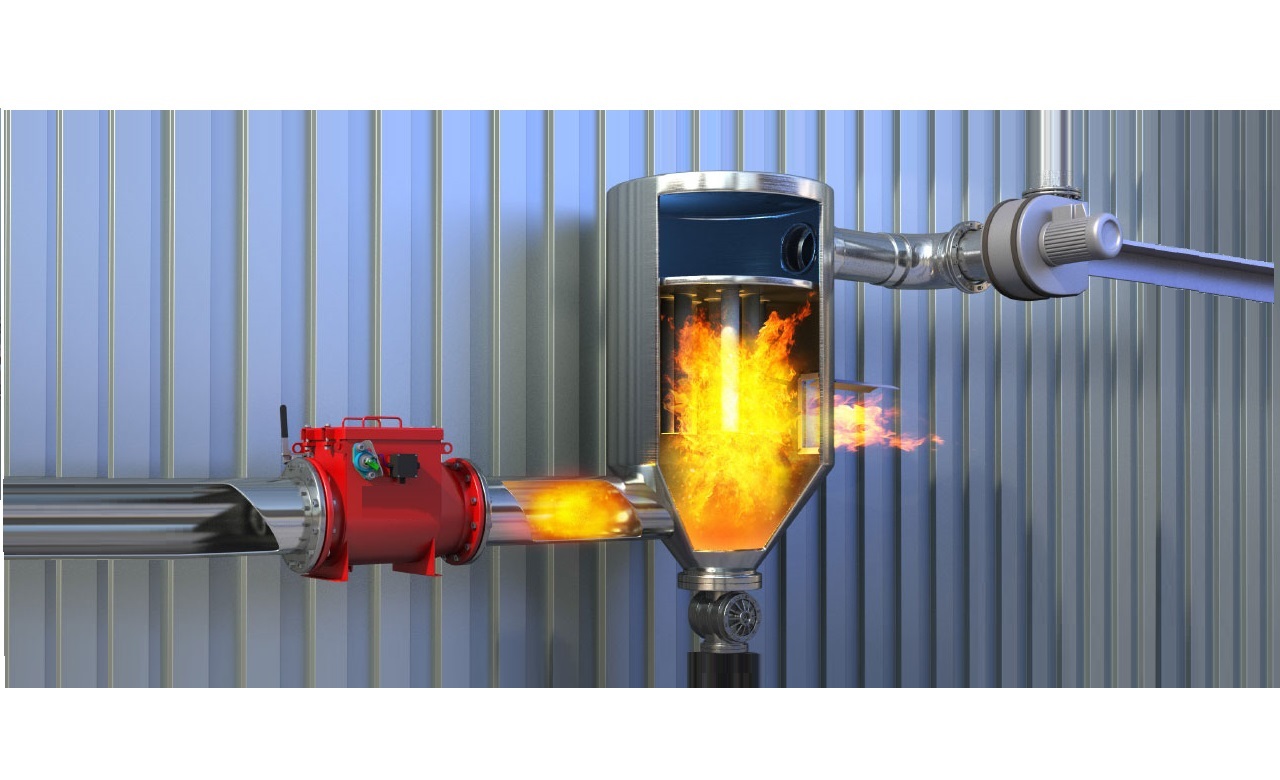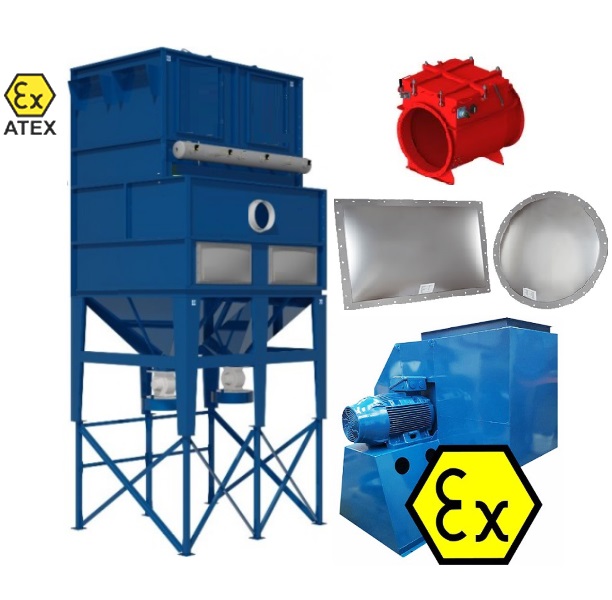

DeGATECH is an expert company with years of experience installing reliable dust collection systems that knows how to appropriately design and install ATEX Compliant dust collection and extraction systems.
DeGATECH technical team can be able to guide their customer in following things:
Selection of appropriate size Explosion vents, discharge devices & Explosion Isolation devices.

NFPA Requirements for Explosion Protection and Isolation of Dust Collectors There are five principal NFPA standards that provide appropriate guidance for the safe management of combustible dust, NFPA 61, NFPA 484, NFPA 654, NFPA 655, and NFPA 664. These standards differ, in some cases, with regard to explosion protection and isolation requirements. All explosion vents comply with NFPA 68 latest edition and ATEX. All dust collectors (bag, envelope bag or cartridge style), receivers and vacuum units, after the dust is tested and analyzed, may be fitted with explosion vents as a means of explosion protection. Usually, vents are the least expensive solution. If applied, they need to be compliant with NFPA 68 “Standard on Explosion Protection by Deflagration DeGATECH ng”.
Explosion protection is generally required for a dust collector where an explosion hazard is judged to exist within the unit. Explosion isolation systems are also required where the dust collector is connected to another piece of equipment that presents an explosion hazard or where the upstream ductwork services work areas. Explosion isolation systems are designed to prevent propagation of a deflagration, initiated in one piece of equipment, upstream or downstream of the connected equipment or to prevent propagation of deflagrations to locations where personnel may be working.
Guidelines for Determining if an Explosion Hazard Exists in the Dust Collector Generally speaking, the quantity of dust first entering a dry media-type dust collector is well below the amount necessary to give rise to an explosible dust cloud atmosphere in the dust collector. However, as the dust enters the collector, it is trapped on the filter media and remains there for a period of time until filter cleaning takes place. Cleaning can be as a result of mechanical shaking of the filter media or, in most cases, high pressure (90- 120 psig) air pulse directly to the inside of the cartridge or sock, causing the accumulated dust to be released from the filter media. It is this dense, localized, dust cloud that typically gives rise to an explosion hazard within the dust collector, as defined by NFPA 654. Calculations can be performed to estimate the density of the dust cloud that is formed when the filter media is cleaned. If the concentrations are less than 25% of the Minimum Explosible Concentration, (MEC), then control of fuel can be used as a Basis of Safety per NFPA 69. In order to consider this option, conditions surrounding the operation of the dust collector must be analyzed. Minimally, there must be no dust accumulation on the side walls or any horizontal sections inside the dust collector and, furthermore, the nature of the dust must be such that there is no tendency to clog or blind the filter media. If any of these conditions exists, an explosion hazard must be judged to be present in the dust collection system and either measures for ensuring safety from dust explosion hazards must be provided or alternatively, a performance based design option can be considered. The performance based design report must be prepared by a person with qualifications acceptable to the owner/operator and, in addition, the authority having jurisdiction (AHJ), usually OSHA, is permitted to obtain independent third-party review of the proposed design. The approach allows for consideration of credible ignition sources as a prerequisite for flash fire or explosion and measures designed to eliminate or control them. The NFPA standards that govern combustible dust provide general requirements if this approach is taken.
Recognising static hazard is key to countering dust explosion danger, When the inside of the collector reaches a predetermined pressure, the explosion vent opens, allowing the excess pressure and flame front to exit to a safe area. It’s designed to safely vent the gases and pressures from a deflagration to minimize damage and injury to workers in the area.
All explosion vents comply with NFPA 68 latest edition and ATEX. All dust collectors (bag, envelope bag or cartridge style), receivers and vacuum units, after the dust is tested and analyzed, may be fitted with explosion vents as a means of explosion protection. Usually, vents are the least expensive solution. If applied, they need to be compliant with NFPA 68 “Standard on Explosion Protection by Deflagration DeGATECH”.
Recognising static hazard is key to countering dust explosion danger, When the inside of the collector reaches a predetermined pressure, the explosion vent opens, allowing the excess pressure and flame front to exit to a safe area. It’s designed to safely vent the gases and pressures from a deflagration to minimize damage and injury to workers in the area.
All explosion vents comply with NFPA 68 latest edition and ATEX. All dust collectors (bag, envelope bag or cartridge style), receivers and vacuum units, after the dust is tested and analyzed, may be fitted with explosion vents as a means of explosion protection. Usually, vents are the least expensive solution. If applied, they need to be compliant with NFPA 68 “Standard on Explosion Protection by Deflagration DeGATECH”.
Questions to be answered to select an explosion vent? We’ll need to know from our customer …
– Kst of the dust/ MSDS of the dust
– Equipment Position and its location
– maximum explosion pressure or Pmax in bar (from dust test results).
There are two types of explosion vents available. First are Explosion Vents or Panels, which are fixed and non-resettable, and when ruptured, are positioned to direct a fireball in a calculated safe direction away from a building or structure. Second are Flameless Explosion Vents, or “indoor vents”, which are applied inside a facility and quench the explosion fire ball at its source.
Summary Dust collectors are used for a wide variety of applications in industry, including removal of dust from manufacturing operations that produce fine particulate and separation of particulate from the airstream where material transfer operations are taking place or where bins and silos are receiving product. This article has described the various NFPA standards that provide guidance for the safe management of combustible dusts and their respective prescriptive requirements with regard to explosion protection and isolation for dry dust collection systems. Where explosion protection is deemed to be the only practical method for reducing the risk of a dust cloud explosion to an acceptable level, various options are discussed and the pros and cons of each method described. This article should provide those responsible for design and management of dust collection systems with guidance with regard to selection of the appropriate systems, based on the logistics involved. DeGATECH Safety Solutions vents are Easy to install and maintain. Custom designs available on quick delivery designs. DeGATECH recommends to maintain 1 spare replaceable kit in case of any emergency.
ATEX COMPLIANT AND SPARK RESISTANT FANS FOR HAZARDOUS ENVIRONMENTS ARE ALSO VERY NECESSARY. DeGATECH explosion-proof fans are engineered to perform in the harshest environments. We combine quality manufacturing with rigorous testing to produce industrial fans you can depend on. We have several of explosion-proof fans in our catalogue that are manufactured to meet the requirements of the ATEX Directive. Enquiries are handled by our dedicated applications team, who understand the detailed approach needed for hazardous area projects. All ATEX fans are subjected to rigorous assessments to determine the correct design features and to confirm that they meet the authoritative standard. Our standard contains design, manufacturing, testing, marking & internal certification procedures and all ATEX complaint & Spark resistant fans are subjected to a running test.
SCHEDULED INSPECTION, REPAIR AND MAINTENANCE
Dust collection and explosion device periodic health checks can reduce impacts from dust explosions. Regular inspection, repair and maintenance of your dust collection systems and explosion vents or panels is required. Keeping all electrical and mechanical equipment in good repair. Regularly inspecting all grounded and bonded equipment to ensure the bonds are in good condition. Checking equipment that may wear such as bearings and valves
APPLICATIONS
– Chemical manufacturing such as rubber, plastics and pharmaceuticals
– Coal-fired power plants
– Food production
– Grain elevators
– Metal processing such as zinc, magnesium, aluminum and iron
– Recycling facilities including plants processing paper, plastics, and metals
– Woodworking facilities
Educational Youtube video, nicely explained on Dust Explosion & its causes:
– Highly effective removal of sparks and cigarette butts
– Compact in design
– Divisible body: for easy maintenance
– Duct clamp connections: for easy installation, service and dismantling
– Optional: inspection hatches for regular checks
– Most advanced spark suppressor technology available in todays market.
– Extinguishes and cools sparks / burning embers from welding fumes, plasma cutting table, grinding, polishing, buffing, belt sanders, furnaces, biomass boilers, and any application which creates a possible spark hazard.
– Prevents fires and explosions in all dust collection systems.
– Static device, with no moving parts, requiring no additional dust collection recipient. No water or chemical retardants are injected.
– DeGATECH spark arrestors device, is easy to apply, install, use and maintain.
– A small investment for safety and big piece of mind.
– DeGATECH Spark Arrestors are available for 4″ to 60″ duct standard and larger or custom sizes, with capabilities in excess of 200,000 CMH
OUR CARTRIDGE FILTERS
DeGATECH also manufactures and supplies custom and in stock Cartridge filters for any type of Cartridge Dust Collector. Our dust collector Filter Cartridges are available in many top and bottom configurations and a variety of filter media options to handle the dust load and dust properties of your work environment.